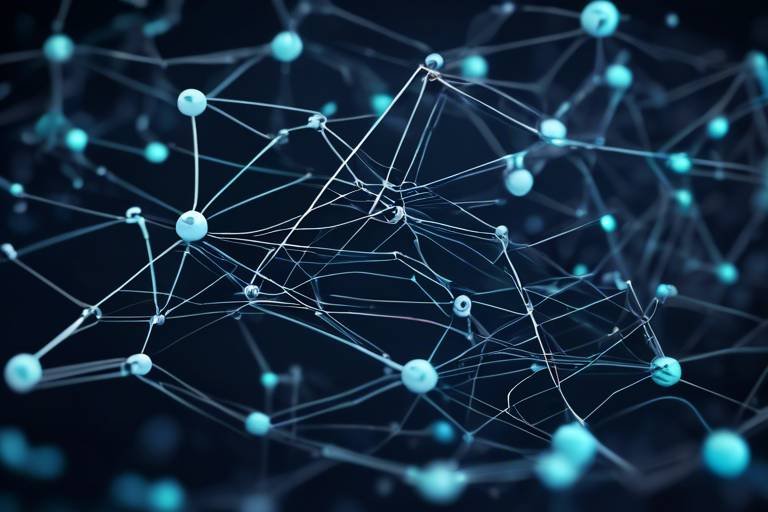Matic Network - Enhancing Ethereum's Scalability
In the ever-evolving world of blockchain technology, one of the most pressing challenges has been the issue of scalability. As more users flock to decentralized applications (dApps) and the Ethereum network, the demand for faster and cheaper transactions has skyrocketed. Enter Matic Network, a revolutionary Layer 2 scaling solution that is not just a band-aid for Ethereum's scalability woes but a robust framework designed to enhance the overall user experience. Imagine trying to get through a crowded subway station during rush hour; the chaos can be overwhelming. Matic Network acts like a well-organized express train, helping users bypass the congestion and reach their destinations swiftly.
Matic Network employs a unique architecture that integrates seamlessly with the Ethereum blockchain, allowing it to leverage Ethereum's security while providing significantly improved transaction speeds and lower costs. By utilizing techniques such as sidechains and the Plasma framework, Matic has positioned itself as a game-changer in the blockchain ecosystem. Think of it as a high-speed lane on a busy highway, providing a clear path for vehicles (transactions) to speed through without getting stuck in traffic. This article will explore how Matic Network enhances Ethereum's scalability, its key features, and the benefits it brings to developers and users alike.
The implications of Matic Network extend far beyond just improving transaction speeds. With its ability to handle thousands of transactions per second (TPS), it opens up new avenues for dApp developers and users, fostering a thriving ecosystem that encourages innovation and growth. Imagine a bustling marketplace where vendors can sell their goods without the hassle of long lines and delays; that's the experience Matic Network aims to create within the blockchain space. As we delve deeper into the architecture of Matic Network and its standout features, you'll see how it not only resolves current issues but also sets the stage for a more scalable and user-friendly Ethereum.
In conclusion, Matic Network is not just a solution to Ethereum's scalability problems; it represents a paradigm shift in how we think about blockchain technology. With its innovative approach to enhancing transaction speed and reducing costs, Matic is paving the way for a new generation of decentralized applications that can operate seamlessly and efficiently. Whether you're a developer looking to build the next big dApp or a user seeking a smooth experience, Matic Network is the express train you want to hop on.
- What is Matic Network? Matic Network is a Layer 2 scaling solution for Ethereum aimed at enhancing transaction speed and reducing costs.
- How does Matic Network improve scalability? It utilizes sidechains and the Plasma framework to allow faster and cheaper transactions off the main Ethereum chain.
- What are the benefits of using Matic Network? Users can enjoy faster transactions, lower fees, and a better overall experience when using dApps built on Matic.
- Are there any challenges associated with Matic Network? Yes, challenges include security concerns and the complexity of implementing the Plasma framework.

Understanding Matic Network
Matic Network, now known as Polygon, is a revolutionary Layer 2 scaling solution for Ethereum, aiming to tackle one of the biggest challenges facing the blockchain world today: scalability. As Ethereum has grown in popularity, the network has faced issues such as high transaction fees and slow processing times, especially during peak usage. Matic Network steps in to bridge this gap, offering a way to enhance transaction speed and reduce costs without compromising security.
The architecture of Matic Network is quite fascinating. It operates on a combination of technologies that work harmoniously with the Ethereum blockchain. At its core, Matic utilizes a unique combination of Plasma chains and Proof of Stake (PoS) mechanisms. This enables it to process transactions off the main Ethereum chain, thereby alleviating congestion and allowing for a smoother user experience. Imagine a busy highway filled with traffic; Matic Network acts like an express lane that lets you bypass the gridlock, getting you to your destination much faster.
One of the standout features of Matic Network is its ability to create child chains that operate independently while still being anchored to the Ethereum main chain. This means that developers can create their own customized environments for their decentralized applications (dApps), tailored to their specific needs. The flexibility offered by Matic is akin to having a customizable office space where you can set up everything just the way you like it, without the constraints of a traditional office layout.
Moreover, Matic Network integrates seamlessly with existing Ethereum infrastructure, making it easy for developers to transition their projects onto this platform. This integration not only enhances the overall efficiency of dApps but also opens up new avenues for innovation and creativity in the blockchain space. Developers can leverage Matic's technology to build high-performance applications that can handle a larger volume of transactions, ultimately leading to a more vibrant and diverse ecosystem.
In summary, Matic Network is not just a solution; it's a game-changer for Ethereum's scalability issues. By combining innovative technologies and a user-friendly approach, it enables faster transactions and lower fees. The future looks bright for dApps built on Matic, as they can now thrive in an environment that prioritizes speed and efficiency. So, whether you're a developer looking to build the next big dApp or a user seeking a seamless experience, Matic Network has something to offer everyone.

Key Features of Matic Network
Matic Network, now known as Polygon, is not just another blockchain solution; it's a game-changer for Ethereum's scalability. One of its most significant attributes is its ability to process transactions faster and at a fraction of the cost compared to the Ethereum mainnet. The architecture of Matic Network combines several innovative features that work harmoniously to enhance the overall efficiency of decentralized applications (dApps). Let's dive into the standout features that make Matic Network a vital player in the blockchain ecosystem.
At the core of Matic Network's architecture is the Plasma framework. This framework allows developers to create child chains that operate independently while still being anchored to the Ethereum main chain. Imagine a busy highway (Ethereum) and the side roads (child chains) that take some of the traffic off the main route, allowing for smoother and faster travel. This analogy perfectly encapsulates how Plasma works, as it facilitates the processing of transactions off the main Ethereum chain, alleviating congestion and improving transaction speeds.
The Plasma framework is a revolutionary concept that enables the creation of these child chains. By offloading transactions from the Ethereum main chain, Plasma significantly reduces the load on the network. This means that transactions can be processed in a matter of seconds instead of minutes, which is a critical improvement for users and developers alike. Furthermore, because these child chains can operate independently, they can be customized to meet specific needs, making Matic Network a flexible solution for various applications.
The benefits of using the Plasma framework are manifold. First and foremost, it provides faster transaction processing, which is essential in today's fast-paced digital economy. With Matic Network, users experience transaction times that are often up to 10 times faster than those on the Ethereum mainnet. Additionally, the lower fees associated with processing transactions on Matic Network make it an attractive option for developers looking to minimize costs. In fact, transaction fees can be reduced by as much as 90% when using Matic compared to Ethereum. This significant reduction in costs and increase in speed are compelling reasons for developers to choose Matic Network for their dApps.
However, it’s essential to recognize that while Plasma offers numerous advantages, it is not without its challenges. One of the primary concerns is security. Since child chains operate independently, there is a risk that they may not be as secure as the main Ethereum chain. This could lead to vulnerabilities that malicious actors might exploit. Additionally, the complexity of implementing Plasma can be daunting for some developers, requiring a steep learning curve. These challenges highlight the need for ongoing development and improvement within the Matic Network ecosystem.
Another critical feature of Matic Network is its use of sidechains. These are independent blockchains that are compatible with Ethereum, allowing for seamless interaction between different networks. By utilizing sidechains, Matic Network can significantly enhance transaction throughput and speed. Think of sidechains as dedicated express lanes on a highway; they allow for faster travel without disrupting the main flow of traffic. This capability is vital for applications that require high transaction volumes, such as gaming or decentralized finance (DeFi) platforms.
In summary, Matic Network's key features—such as the Plasma framework and sidechains—are designed to enhance scalability and improve the overall user experience. By providing faster transaction speeds and lower fees, Matic Network not only benefits developers but also attracts a broader user base to decentralized applications. The combination of these features positions Matic Network as a leading solution for Ethereum scalability, paving the way for a more efficient blockchain ecosystem.

Plasma Framework
The is a revolutionary component of the Matic Network that plays a pivotal role in enhancing Ethereum's scalability. Imagine a bustling highway where traffic is constantly piling up, causing frustrating delays. Now, envision an alternative route that allows cars to bypass the congestion, thus improving the overall flow. This is essentially what Plasma does for Ethereum transactions. By enabling the creation of child chains, Plasma allows transactions to be processed off the main Ethereum chain, effectively reducing the load and speeding up transaction times.
At its core, Plasma operates on the principle of layering. It establishes a hierarchy of child chains that can execute transactions independently while still being anchored to the Ethereum mainnet. This means that developers can build decentralized applications (dApps) that can handle a significantly higher volume of transactions without overwhelming the Ethereum blockchain. The child chains can periodically communicate with the main chain, ensuring security and integrity while allowing for a much faster transaction processing time.
One of the standout features of the Plasma Framework is its ability to facilitate off-chain transactions. This is crucial for applications that require quick, real-time interactions, such as gaming or finance. With Plasma, users can enjoy lightning-fast transactions while incurring minimal fees, making it an attractive option for developers looking to create seamless user experiences. For instance, a gaming dApp could utilize Plasma to handle thousands of transactions per second, allowing players to interact without frustrating delays.
However, the Plasma Framework is not without its challenges. While it offers significant scalability benefits, it also introduces complexities in terms of security and user experience. Users must be aware of how to withdraw their assets from child chains back to the main Ethereum chain, which can sometimes be a cumbersome process. Moreover, the security of the child chains relies heavily on the mechanisms in place to ensure that they remain trustworthy. As Matic Network continues to evolve, addressing these challenges will be crucial for its widespread adoption.
In summary, the Plasma Framework is a game-changer for the Ethereum ecosystem, providing the necessary infrastructure to support a new wave of scalable dApps. By allowing for off-chain processing and reducing congestion on the main chain, it opens up a world of possibilities for developers and users alike. As we move forward, the synergy between Plasma and Matic Network will undoubtedly shape the future of decentralized applications, making them more efficient, faster, and user-friendly.

Benefits of Plasma
The Plasma framework is a game-changer in the world of blockchain technology, particularly for Ethereum. By enabling the creation of child chains, Plasma significantly enhances the scalability of the network. One of the most compelling benefits of Plasma is its ability to process transactions much faster than the main Ethereum chain. Imagine a bustling city where traffic jams are the norm; now picture a high-speed train that bypasses all the congestion. That’s what Plasma does for Ethereum transactions—it allows them to zoom through with minimal delays.
Another key advantage of Plasma is the reduction in transaction fees. On the Ethereum mainnet, users often face exorbitant gas fees during peak times, making simple transactions costly. With Plasma, the cost to execute transactions is drastically lowered, which is particularly appealing for developers and users alike. This affordability opens the door for more people to engage with decentralized applications (dApps), effectively democratizing access to blockchain technology.
Moreover, Plasma enhances security through its unique architecture. Each child chain can operate independently while still being anchored to the Ethereum mainnet. This means that even if one child chain experiences issues, the integrity of the main Ethereum network remains intact. In essence, it’s like having multiple backup systems; if one fails, the others can still function smoothly. This layered security model not only protects users but also builds trust in the ecosystem.
In addition to speed, cost-effectiveness, and security, Plasma also facilitates a more efficient user experience. Users can enjoy quick confirmations and reduced waiting times, which is crucial in today’s fast-paced digital world. The seamless interactions enabled by Plasma can lead to higher user satisfaction and retention rates. When users know they can execute transactions swiftly and at a lower cost, they are more likely to engage with dApps and explore the possibilities of blockchain technology.
To summarize, the benefits of the Plasma framework are multifaceted:
- Faster transaction processing: Enables swift execution of transactions, reducing wait times.
- Lower fees: Decreases the cost of transactions, making blockchain more accessible.
- Enhanced security: Protects the integrity of the main chain while allowing independent operations.
- Improved user experience: Increases user satisfaction through quick and efficient transactions.
These advantages make Plasma an attractive option for developers looking to build scalable dApps on the Matic Network. As the blockchain ecosystem continues to evolve, embracing innovative solutions like Plasma will be crucial in meeting the growing demands of users and developers alike.

Challenges of Plasma
While the Plasma framework offers exciting possibilities for enhancing scalability on the Matic Network, it is not without its challenges. One of the primary concerns is security. As transactions are processed off the main Ethereum chain, there is a risk that these child chains could become targets for malicious attacks. If a child chain is compromised, users could potentially lose their assets, leading to a lack of trust in the system. This is particularly concerning for developers and users who prioritize security in their blockchain interactions.
Another significant challenge is the complexity of implementing Plasma. For many developers, the intricacies involved in setting up and managing child chains can be daunting. The learning curve associated with understanding how Plasma operates and how to effectively utilize it can deter new developers from exploring this technology. It’s akin to learning a new language; while the rewards can be great, the initial hurdles can be overwhelming.
In addition to security and complexity, there are also issues related to interoperability. As various projects adopt different implementations of Plasma, ensuring seamless communication between these systems can be problematic. Without a standardized approach, developers may face difficulties in integrating their dApps across various platforms. This fragmentation can lead to inefficiencies and a disjointed user experience.
Moreover, the exit mechanisms of Plasma chains can be a source of concern. Users must be able to withdraw their assets from child chains back to the main Ethereum chain safely and efficiently. If the exit process is complicated or slow, it could deter users from utilizing Plasma altogether. A cumbersome exit could lead to frustration and could potentially negate the benefits of faster transactions.
To summarize, while Plasma enhances scalability and provides numerous advantages, it also brings forth challenges that need to be addressed for widespread adoption. The concerns around security, complexity, interoperability, and exit mechanisms must be carefully navigated to ensure that Matic Network can fulfill its promise of a more scalable Ethereum ecosystem.
- What is Plasma? Plasma is a framework that allows for the creation of child chains, enabling faster and cheaper transactions on the Ethereum network.
- How does Plasma enhance scalability? By processing transactions off the main Ethereum chain, Plasma reduces congestion and increases transaction throughput.
- What are the security risks associated with Plasma? The main risks involve potential attacks on child chains, which could compromise user assets.
- Is it difficult to implement Plasma? Yes, the complexity of managing child chains can be a significant barrier for many developers.
- How do users withdraw funds from Plasma? Users need to follow specific exit mechanisms to transfer their assets from child chains back to the main Ethereum chain.

Sidechains Explained
Sidechains are a crucial component of the Matic Network's architecture, acting as independent blockchains that operate parallel to the main Ethereum chain. Think of them as separate highways that connect to a bustling city (Ethereum) but allow for faster travel without getting stuck in traffic. This innovative approach enhances scalability by enabling a higher transaction throughput—meaning more transactions can be processed at once, which is vital for blockchain applications that require speed and efficiency.
By utilizing sidechains, Matic Network allows developers to create specific environments tailored to their dApps without congesting the main Ethereum network. Each sidechain can have its own consensus mechanism and can be optimized for specific use cases, leading to improved performance and lower fees. For instance, a gaming dApp might require different parameters compared to a financial application, and sidechains provide the flexibility to cater to these varying needs.
Furthermore, sidechains facilitate seamless asset transfers between the main chain and the sidechains. This interoperability is essential for maintaining the integrity of the ecosystem while allowing users to enjoy the benefits of lower transaction costs and faster speeds. Users can easily transfer their assets to a sidechain, conduct their transactions, and then move back to the main Ethereum chain when needed. This fluidity not only enhances user experience but also encourages more developers to build on the Matic Network.
To illustrate the impact of sidechains, consider the following table that summarizes their key advantages:
| Advantage | Description |
|---|---|
| Scalability | Increased transaction throughput allows for more users and applications without slowing down. |
| Cost Efficiency | Lower transaction fees make it more affordable for users and developers. |
| Customizability | Developers can tailor sidechains to meet specific needs of their applications. |
| Interoperability | Assets can be transferred easily between the main chain and sidechains. |
In summary, sidechains are not just an add-on to the Matic Network; they are a pivotal feature that enhances the entire ecosystem. By allowing independent blockchains to operate alongside Ethereum, Matic Network is paving the way for a more scalable, efficient, and user-friendly blockchain experience. With the ability to customize environments for various applications, sidechains empower developers to innovate without the constraints typically associated with the main Ethereum chain.
- What are sidechains in the context of Matic Network?
Sidechains are independent blockchains that operate parallel to the Ethereum main chain, allowing for faster transactions and reduced congestion. - How do sidechains improve scalability?
By processing transactions off the main chain, sidechains increase overall transaction throughput, enabling more users and applications to operate simultaneously. - Can I transfer assets between sidechains and the Ethereum main chain?
Yes, Matic Network allows for seamless asset transfers between the main chain and sidechains, enhancing user experience and flexibility. - Are there any security risks associated with sidechains?
While sidechains offer many benefits, they also present unique security challenges that need to be addressed to ensure safe transactions.

Benefits for Developers
The Matic Network is a game changer for developers looking to build scalable decentralized applications (dApps). Imagine trying to build a skyscraper on a shaky foundation; that's what developing on Ethereum's mainnet can feel like due to its inherent limitations. Matic offers a robust platform that not only enhances scalability but also provides a suite of features tailored specifically for developers. The integration of Matic's Layer 2 solutions allows developers to create dApps that are not only efficient but also cost-effective, thus enabling them to focus more on innovation rather than grappling with issues like high gas fees and slow transaction speeds.
One of the most significant advantages Matic brings to the table is the reduction in transaction fees. Developers can save a considerable amount of money when deploying their applications because Matic's Layer 2 solutions significantly lower the costs associated with each transaction. This cost efficiency is crucial, especially for startups and smaller projects that may not have the financial backing to sustain high operational costs. With Matic, developers can allocate their resources more effectively, leading to a more sustainable development cycle.
Additionally, the improved transaction speed on the Matic Network is another compelling reason for developers to make the switch. Instead of waiting for transactions to be confirmed on Ethereum’s congested mainnet, Matic allows for near-instant confirmations. This improvement not only enhances the user experience but also enables developers to create more dynamic applications that can handle real-time interactions. Think about it: if you’re building a gaming dApp, wouldn't you want your users to experience seamless gameplay without frustrating delays?
Moreover, Matic Network supports a variety of programming languages and tools, making it incredibly accessible for developers from diverse backgrounds. Whether you’re a seasoned Solidity developer or someone who prefers using JavaScript, Matic allows you to integrate your skills into the blockchain ecosystem effortlessly. This flexibility opens the door for a wider range of developers to participate in the burgeoning world of dApps, fostering innovation and creativity.
To summarize, here are some key benefits Matic Network offers developers:
- Lower Development Costs: Reduced transaction fees lead to significant savings.
- Faster Transactions: Near-instant transaction confirmations improve user experience.
- Flexible Development Environment: Compatibility with various programming languages and tools.
In conclusion, Matic Network not only enhances Ethereum's scalability but also empowers developers to create high-quality dApps without the usual constraints. By providing a platform that prioritizes efficiency and cost-effectiveness, Matic is paving the way for a new era of decentralized applications that can thrive in an increasingly competitive landscape.
Q1: What is Matic Network?
A1: Matic Network, now known as Polygon, is a Layer 2 scaling solution designed to enhance the scalability of Ethereum by providing faster transactions and lower fees.
Q2: How does Matic Network improve transaction speeds?
A2: Matic achieves faster transaction speeds by using a unique combination of technologies, including sidechains and the Plasma framework, which allows transactions to be processed off the main Ethereum chain.
Q3: Are there any security concerns with using Matic Network?
A3: While Matic Network offers significant benefits, developers must consider potential security challenges, such as the complexities of managing child chains and ensuring that user assets are safe during transactions.
Q4: Can I build any type of dApp on Matic Network?
A4: Yes, Matic Network is designed to support a wide range of dApps, including gaming, finance, and social applications, making it a versatile choice for developers.

Lower Development Costs
One of the most compelling advantages of Matic Network is the significant reduction in development costs for decentralized applications (dApps). In the world of blockchain, where every transaction can incur hefty fees, Matic Network shines like a beacon of hope for developers. Imagine being able to build and deploy your dApp without constantly worrying about the financial burden of transaction costs. That’s exactly what Matic offers!
By utilizing Matic’s Layer 2 scaling solution, developers can enjoy lower transaction fees while still harnessing the power of Ethereum’s security and ecosystem. This is achieved through a combination of the Plasma framework and sidechains, which allow for off-chain transactions. The result? A more cost-effective environment for creating and managing dApps. As a developer, you can focus on innovation and creativity rather than getting bogged down by excessive costs.
To illustrate the difference, let’s consider a simple comparison table:
| Aspect | Traditional Ethereum | Matic Network |
|---|---|---|
| Transaction Fee | $1 - $10 (varies) | Less than $0.01 |
| Transaction Speed | 15 seconds - several minutes | 2 seconds |
| Scalability | Limited | High |
As you can see from the table above, Matic Network drastically reduces both the cost and time associated with transactions. This means that developers can deploy their dApps much more efficiently, allowing for rapid iteration and improvement. Furthermore, with the ability to conduct transactions at such a low cost, developers can experiment more freely, testing new features and functionalities without the fear of incurring high fees.
Moreover, Matic Network's user-friendly interface simplifies the development process. With easy-to-use tools and comprehensive documentation, even developers who are relatively new to blockchain technology can quickly get up to speed. This accessibility not only lowers the barrier to entry for new developers but also encourages a wider range of creativity and innovation within the ecosystem.
In conclusion, the associated with Matic Network make it an attractive option for developers looking to create scalable and efficient dApps. By alleviating the financial pressures of transaction fees, Matic empowers developers to focus on what truly matters: building amazing applications that can change the world.
- What is Matic Network? Matic Network is a Layer 2 scaling solution for Ethereum that enhances transaction speed and reduces costs.
- How does Matic Network lower development costs? By utilizing off-chain transactions and a user-friendly interface, Matic significantly reduces transaction fees and speeds up development.
- Can I build any type of dApp on Matic Network? Yes! Matic Network supports a wide range of decentralized applications, making it a versatile platform for developers.
- Is Matic Network secure? Yes, Matic Network leverages the security of the Ethereum blockchain while enhancing scalability and efficiency.

Improved User Experience
When it comes to decentralized applications, the user experience can often be a make-or-break factor. With Matic Network, users can expect a significant enhancement in their overall experience. Imagine trying to send a message, but it takes forever to deliver. Frustrating, right? Well, that’s how users often feel when they deal with slow transaction speeds on traditional Ethereum. Matic Network tackles this issue head-on by offering faster transaction times that can be completed in a matter of seconds.
One of the standout features of Matic is its ability to reduce transaction fees dramatically. Think of it like shopping during a sale: wouldn't you prefer to pay less for the same product? Matic allows users to enjoy the benefits of blockchain technology without burning a hole in their wallets. The reduced fees mean that users can engage in more transactions without worrying about costs piling up. This is especially beneficial for microtransactions, where every penny counts.
Moreover, Matic Network's architecture ensures that transactions are not only fast but also secure and reliable. Users can enjoy peace of mind knowing that their transactions are being processed on a robust platform that prioritizes security. This reliability fosters trust, which is crucial in the world of decentralized finance (DeFi) and dApps.
Another aspect that enhances user experience is the seamless integration of Matic with existing Ethereum wallets. Users don’t need to jump through hoops to access the benefits of Matic; they can simply use their familiar wallets to interact with Matic-powered dApps. This user-friendly interface minimizes the learning curve, making it easier for newcomers to dive into the world of blockchain.
In addition to these features, Matic Network supports a wide range of dApps, from gaming to finance, which means users have access to a rich ecosystem. This diversity ensures that users can find applications that suit their needs, whether they are looking to trade, invest, or play. The more options available, the more likely users are to engage with the platform. In fact, the variety of dApps can be likened to a buffet, where users can pick and choose according to their tastes.
To sum it up, Matic Network is not just about speed and cost; it’s about creating a holistic experience that keeps users coming back for more. With its focus on improved transaction speeds, lower fees, and a seamless user interface, Matic is paving the way for a more user-friendly blockchain experience. As the blockchain ecosystem continues to grow, Matic Network stands out as a beacon of innovation, making it easier and more enjoyable for users to engage with decentralized applications.
- What is Matic Network? Matic Network is a Layer 2 scaling solution for Ethereum that enhances transaction speed and reduces costs.
- How does Matic improve user experience? Matic improves user experience through faster transaction times, lower fees, and a user-friendly interface.
- Can I use my existing Ethereum wallet with Matic? Yes, Matic integrates seamlessly with existing Ethereum wallets, making it easy for users to access its benefits.
- What types of applications can I find on Matic? Matic supports a diverse range of decentralized applications, including those in gaming, finance, and more.
Frequently Asked Questions
- What is Matic Network?
Matic Network is a Layer 2 scaling solution designed to improve the scalability of the Ethereum blockchain. By enhancing transaction speed and reducing costs, it allows for a more efficient and user-friendly experience for decentralized applications (dApps).
- How does Matic Network enhance Ethereum's scalability?
Matic Network employs various technologies, including the Plasma framework and sidechains, to process transactions off the main Ethereum chain. This reduces congestion on the Ethereum network, allowing for faster and cheaper transactions.
- What are the key features of Matic Network?
The key features of Matic Network include the Plasma framework, which enables the creation of child chains, sidechains that allow independent blockchains to interact with Ethereum, and a user-friendly interface that simplifies the development of dApps.
- What benefits does Plasma provide?
Plasma enhances transaction processing speed and lowers fees, making Matic Network an attractive option for developers and users. It allows for faster confirmation times and reduces the overall cost of transactions.
- Are there any challenges associated with Plasma?
Yes, despite its benefits, Plasma faces challenges such as security concerns and complexity in its implementation. These issues can impact the adoption of Matic Network and require careful consideration by developers.
- What role do sidechains play in Matic Network?
Sidechains are crucial for Matic's scalability as they enable independent blockchains to operate alongside Ethereum. This interaction boosts transaction throughput and speed, ultimately leading to a more efficient ecosystem.
- How does Matic Network benefit developers?
Matic Network offers developers a robust platform that significantly reduces development costs due to lower transaction fees and faster processing times. This allows for more efficient dApp creation and deployment.
- What improvements does Matic Network provide for user experience?
By offering faster transactions and lower fees, Matic Network greatly enhances the user experience. These improvements help attract more users to dApps built on the Matic platform, making them more competitive in the market.



















